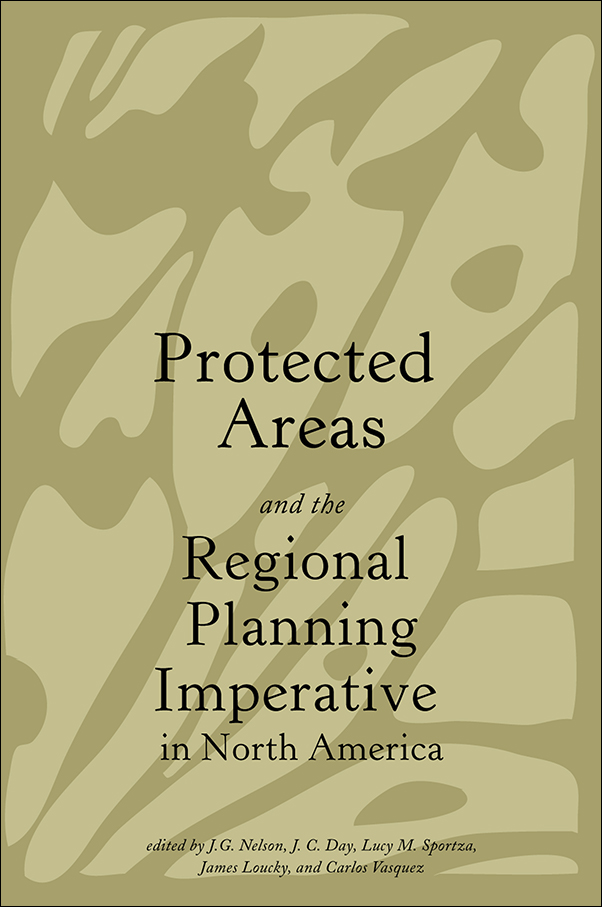
Protected Areas and the Regional Planning Imperative in North America
Edited by J.G. Nelson, J. C. Day, Lucy M. Sportza, James Loucky, and Carlos Vasquez
$39.95 CAD / $39.95 USD
444 pages, 119 illustrations
6 x 9 inches
Paperback: 978-1-55238-084-0
Library PDF: 978-1-55238-435-0
March 2003
An eloquent illustration of the importance of trans-boundary cooperation in the conservation of biological diversity and a unique and valuable contribution to the study of protected areas.
Regional planning is imperative if North America has any hope of retaining continental biodiversity and environmentally, socially, and economically sustainable development.
This timely collection of essays presents new protected area theory, method, and practice as an explicit part of regional planning. With a North American focus, these essays consider the history of ecology, policy, and planning of protected areas in the context of the fundamental need for a linkage with ongoing regional planning.
Protected areas and regional planning must be pursued, not as separate, but rather as interrelated activities if both are to achieve their place in decision-making in North America.
With Contributions By: JG Nelson, JC Day, Lucy Sportza, Carlos Israel Vázquez, James Loucky, Keven McNamee, Scott Brennan, John C Miles, Carlos Castillo S, Bruce AB Currie-Alder, Christopher Gosselin, Graham Forbes, Stephen Woodley, Bill Freedman, Patrick Lawrence, Heather Black, Kenneth W Cox, Sabine Jessen, Natalie Ban, Marvin O Jensen, Steve Gatewood, Christopher E Williams, Exequiel M Ezcurra, Roberto Martínez, Ilena Espejel, Noél Arón Fuentes, Gustavo D. Danemann, Lina Ojeda Revah, Ella Vázquez-Domínguez, Alejano Robles, Hans Hermann, Jürgen Hoth, David Gauthier, and Ed Wicken
J.G. Nelson is distinguished professor emeritus and chair of the Heritage Resources Centre at the University of Waterloo. With over forty years of academic and field experience in environmental studies around the world, he maintains a deep and enduring interest in the creation and management of parks and protected areas.
J.C. Day earned his doctoral degree in integrated water and land management from the University of Chicago. He is an emeritus professor in the School of Resource and Environmental Management, a graduate program at Simon Fraser University.
Lucy M. Sportza teaches in the Department of Geography at the University of Guelph.
Foreword
Preface
Acknowledgments
Overview of Protected Areas and the Regional Planning Imperative in North America
J.G. Nelson, J.C. Day, and Lucy Sportza with Carlos Israel Vazquez and James Louckey
Country Overviews
Preserving Canada’s Wilderness Legacy: A Perspective on Protected Areas
Kevin McNamee
National Parks, Wilderness, and Protected Areas in the United States
Scott Brennan and John C. Miles
The Mexican Park and Protected Area System
Carlos Castillo S., Bruce A.B. Currie-Alder, and J.C. Day
Canada
Regional Approaches to Planning for Protected Areas and Conservation
Lucy M. Sportza
Natural Area Policies in the Regional Municipality of Waterloo: 1973 to 2000 and Beyond
Christopher Gosselin
Making Ecosystem-Based Science into Guidelines for Ecosystem-Based Management: The Greater Fundy Ecosystem Experience
Graham Forbes, Stephen Woodley, and Bill Freedman
Assessing Ecosystem Conservation Plans for Canadian National Parks
J.G. Nelson, Patrick Lawrence, and Heather Black
Linking Public and Private Stewardship: The Sand Dunes National Monument Region, Colorado, and Its Implications for Canada
J.G. Nelson
Wings Across the Border
Kenneth W. Cox
Baja to Bering Sea: A North American Marine Conservation Initiative
Sabine Jessen and Nathalie Ban
United States of America
Tijuana River National Estuarine Research Reserve
Tessa Roper, J.G. Nelson, and J.C. Day
Regional Management Program at Yellowstone National Park
Marvin O. Jensen
Cascades International Park: A Case Study
John C. Miles
The Wildlands Project: The Yellowstone to Yukon Conservation Initiative and Sky Islands Wilderness Network
Steve Gatewood
Ecoregion-based Conservation in the Chihuahuan Desert: Summary of Biological Advancement and Biodiversity Vision
Christopher E. Williams and J.G. Nelson
Parks, Protected Areas, and Environmental Education in North America
John C. Miles and James Louckey
The United States of Mexico
Conservation and Sustainable Use of Natural Resources in Baja California
Exequiel M. Ezcurra
Conservation and Management of Ecosystems Within and Without Protected Natural Aras in Baja California, Mexico
Roberto Martinez and Ileana Espejel
Feasibility of Sustainable Investment Projects in the Northern California Gulf and Colorado River Delta Biosphere Reserve, Mexico
Noel Aron Fuentes and Carlos Israel Vazquez
Parks and Protected Areas in a Local and Regional Context in North America: A Multisectoral Transdisciplinary Approach
Gustavo D. Danemann
Tourism, Protected Aras, Nature Conservation and Sustainable Development in Mexico
Nora L Bringas Rabago and Lina Ojeda Revah
Public Participation in Mexican Pretexted Areas: Terminos Lagoon, Campeche
Bruce A.B. Currie-Alder and J.C. Day
Retrospectives
Canada
Graham Forbes
United States of America
James Louckey
Mexico
Alejandro Robles
Postscript
The Growing Role of the Commission on Environmental Cooperation in Biodiversity and Protected Area Planning in North America
Hans Hermann, Jurgen Hoth, and J.G. Nelson
Conservation of Biodiversity: The North American Conservation Area Database
David Gauthier and Ed Wiken
Index
A unique and valuable contribution to the literature on protected areas.
—Paul F. Wilkinson, Alternatives Journal
The strength of this edited compilation is the attention to the regional and landscape level concern for ecological, socioeconomic, cultural, and land use management issues . . . Overall, this book is an important and unique contribution to building awareness, knowledge, and understanding of the landscape level and the need to integrate nature conservation with sustainable development.
—Chad P. Dawson, Society and Natural Resources
This book is an eloquent illustration of the importance of trans-boundary cooperation in conserving the biological diversity of North America. The examples from Canada, the USA, and Mexico demonstrate convincingly that land-use planners are beginning to think at a landscape scale. The Commission on Environmental Cooperation will be given a boost by this book, which clearly identifies the priorities for Canada, Mexico, and the USA. Landscape planning will never be the same!
—Jeffrey A. McNeely, Cheif Scientist, IUCN-The World Conservation Union